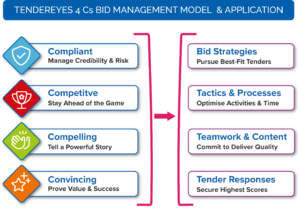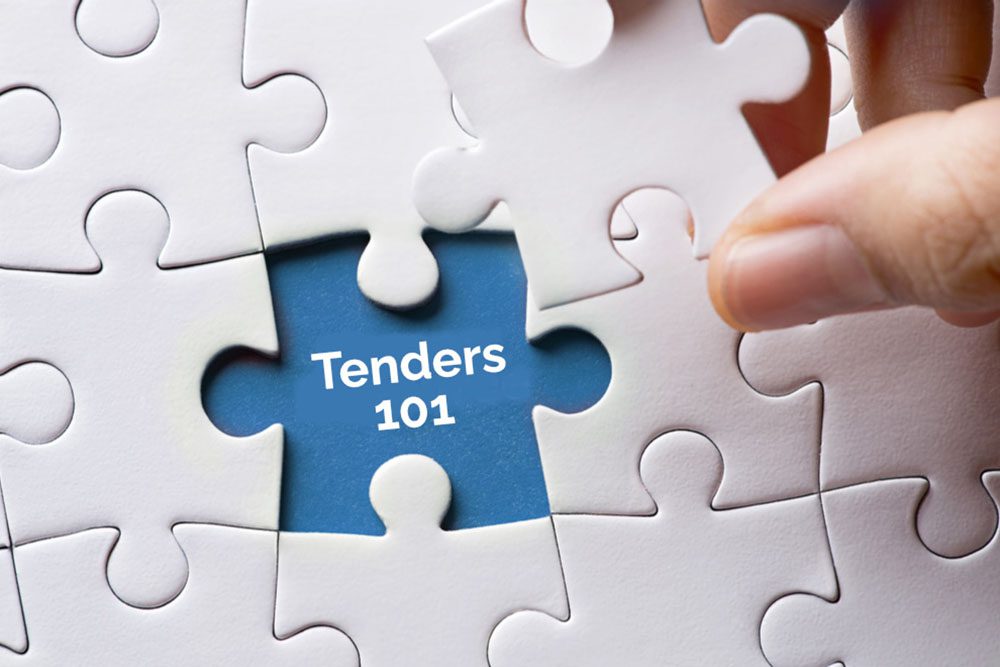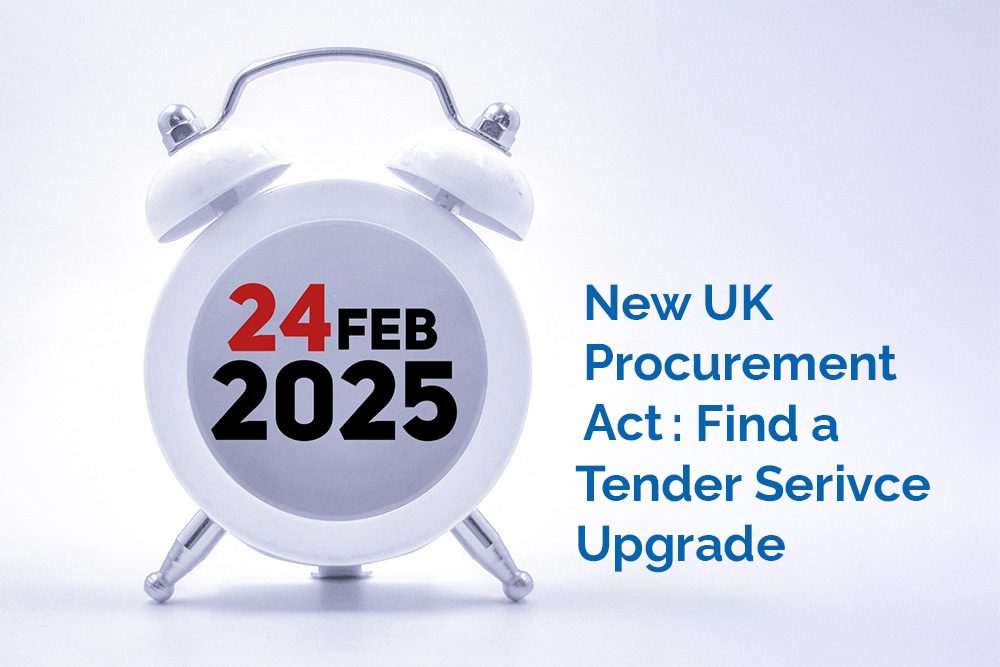Creating competitive advantage in high-value public tendering is extremely challenging. Its not just about the tender submission!
Success depends on a company’s ability to strategically plan, efficiently manage bids, ensure strong governance, and maximise return on investment. A structured bid management approach is essential to gaining advantage in this highly competitive landscape.
In this article we explore the benefits of implementing the above improvement strategies. As well as discuss how adopting a robust bid management system, such as TenderEyes, can put you ahead of your competition!
Before we do that let’s look at the common problems businesses encounter while undertaking bid activities.
Common Challenges in Bid Management
With the complexity of tasks, people and content involved in bidding, it’s understandable that businesses struggle with gaining competitive advantage in their bidding activities.
Focus will be on completing tenders with very tight deadlines. Little time will be available to take stock, review and improve bid management strategies, processes and supporting technology and tools.
Challenges may include:
- Limited understanding of the bidding universe & competitive environment
- Pursuing mis-matched or low win probability bids
- Content in data silos with little quality control
- Managing complex bid projects in spreadsheets
- Little collaboration between contributors
- No formal evaluation or approval processes
- No reviews or improvement plans in place.
This results in inefficiencies and time delays, causing reactive and pressurised working. Thus, giving your teams little opportunity to take time to finesse your tender responses, secure higher evaluation scores and win more business.
Being Competitive in Your Bidding Practices
Being competitive in your bid submissions is a given! Without it you will not win contracts. But how often does your business consider how to be more competitive in your bid management practices and activities?
Imagine you are competing for a contract whilst dealing with the challenges of working inefficiencies, poor collaboration and managing the project within a spreadsheet. Whilst your key competitor has adopted a streamlined and robust approach to bid management utilising a dedicated bid management solution.
They will have more time to craft and finesse their tender submissions and likely win more contracts!
Therefore, every improvement you can make within your bid management activities will contribute to gaining and sustaining your competitive edge! And this needs to start with a review of your existing practices and identifying how you can become more competitive in these areas.
57% of companies state that gaining a competitive advantage is one of the top 3 priorities in their industry (Forbes)
Improved Tender Insight & Planning
Any form of successful strategic planning starts with data analysis and insight. However, this is a big challenge for most businesses involved in bidding activities.
Securing data to properly assess and understand your bidding universe and competitive landscape is difficult. Relevant information within Contract Notices and Awards is held in many procurement portals across the world and in formats not easy to extract and analyse.
You may also have little information on your bidding performance and results, available to analyse.
This means many businesses rely on limited ad hoc information and assumptions to set bid strategies and plans. This may result in poor pursuit activities and threats being unidentified and addressed.
Companies must be able to source, qualify and submit bids effectively, align them with their capabilities, and allocate resources wisely.
A data-driven structured bid management approach supports these efforts and is critical to build and sustain competitor advantage.
- Comprehensive Market Intelligence: Regularly monitoring and understanding your bidding universe and competitive landscape is imperative to making better informed strategic decisions. This will include identification of procurement trends, competitor strategies, and upcoming tenders. This will enable you to hone your pursuit strategies as well as take proactive and early action in responding to new opportunities and threats (Check out TenderEyes Market Insights).
- Strategic Opportunity Qualification: It’s very easy to fall into the trap of pursing mis-matched tender opportunities on the off-chance you may win. But this approach takes up valuable time and resources that could be better spent on refining best-fit submissions.
A well-structured robust qualification process and criteria are essential to ensure pursuit of your best-fit tenders only. These need to be aligned to your business objectives and goals, as well as your products or services, expertise, profitability potential, and resource availability.
- Performance Reviews: When working on multiple bids with tight deadlines it is hard to take the time to review performance and results. However, this is an essential element of bid management best practice. Without it how will you continue to improve and stay ahead of your competitors?
Leveraging performance and results insights from previous bids will help your business identify roadblocks and working inefficiencies as well as poor opportunity targeting and pursuit.
Undertaking regular reviews of standard Questions and Answer pairs and their evaluation scores will also help ensure tender responses are optimised to secure higher evaluation scores. Every point matters!
Assessing tender responses against both the procuring agency and your own criteria, such as the TenderEyes 4 Cs Framework, will allow you to better improve and refine your tender responses for future submissions.
Streamlined Tender Workflows & Activities
Public sector tenders often involve complex processes, numerous people and large volumes of content. However, many teams still operate these projects using generic business applications such as email and spreadsheets. This results in the undertaking of many repetitive manual tasks, poor content management and team collaboration.
These issues can severely hamper timescales and the creation of quality tender submissions. This is certainly a critical area to review and improve to gain competitive advantage.
Implementing a regime of efficiency and collaboration improvements will save valuable time and allow your teams to focus on delivering more competitive tender responses and submissions.
- Rapid Project Mobilisation: Delays are often experienced between and during pursuit decisions and project mobilisation. Having a well-defined process and the right tools for project managing these complex activities is essential.
For example, being able to automatically populate your project with the tender documents, qualification information and sales insight is invaluable. Plus, automatically assign and notify project contributors of their required tasks and attendance at briefing meetings etc. saves additional time and ensures early engagement and commitment.
- Automated Workflows: Streamlining repetitive processes and tasks, such as information requests and reminders, compliance checks, and approval processes reduces administrative burdens and allows your teams to spend more time crafting quality tender responses.
The adoption of structured automation (the use of pre-defined, rule-based systems to automate tasks such as workflows and data handling) will grow significantly, with 70% of organisations adopting it by 2025, up from 20% in 2021. Gartner
- Content and Knowledge Management: One of the biggest and most time-consuming challenges faced by Bid Teams is the sourcing and compilation of information and documentation required for tender submissions. Information is often stored in disparate silos and with different teams or individuals.
Building a well-organised bid library or repository of pre-approved content, templates, and past bid responses will save valuable time. Easy access to content ownership, validity, review and approvals will help ensure information used in submissions is accurate and up to date.
While accessibility to powerful editing tools, AI and integration with Microsoft 365 Apps will significantly speed up the drafting of tender responses and submissions. (Check out the TenderEyes Bid Accelerator).
- Centralised Collaboration: Teamworking is essential to delivering effective bid management. Ensuring that Bid Teams, Subject Matter Experts, and Approvers can work together seamlessly, with easy access to projects and content will reduce roadblocks and improve response quality.

Stronger Tender Governance & Security
With a great deal of intellectual property such as business information and pricing, included within bids, any inaccuracies could not only jeopardise winning but put your business at financial and brand risk.
Therefore, governance and compliance of your internal bid management processes, activities and decision making is essential. The requirements set by the contracting authority also need to be carefully adhered to when submitting bids – any missed requirements may result in poor evaluation scores or even disqualification from the tender process.
A structured bid management approach ensures:
- Clear Approval Processes: Whether it’s signing off opportunity pursuit actions, approving individual tender responses or final submissions, having formal procedures in place is essential to reducing risks and non-compliance. Assigning Approvers and their tasks at the start of projects and keeping them notified throughout the process will help ensure delays are reduced in decision making.
- Auditability and Compliance: A system that ensures approvals are requested, actioned and recorded will help maintain a clear audit trail of bid activities ensuring alignment with internal policies and external regulatory requirements.
- Secure Data Handling: Robust security measures need to be in place to protect intellectual property, financial data, and confidential company insights. Having a system that clearly defines roles, responsibilities and individuals’ data access and use will help manage data handling across the business.
With strong governance, businesses can confidently engage in public sector bidding, safeguarding their reputation and ensuring compliance with contractual obligations.
Greater Bidding Return on Investment
Bidding for complex tenders requires huge investment in both time and resources. Implementing a strategic approach to operational efficiency, resource planning, and overall return on investment (ROI) will help focus activity and improve results.
- Optimised Resource Allocation: Reducing working inefficiencies, leveraging automated workflows, task setting and reminders will give teams the time to focus on the more important aspects of bid management. Proper overview of project deliverables and timescales will help identify and address roadblocks and delays, ensuring better use of tight timescales.
- Continuous Improvement: Taking time to analyse bidding performances and results is essential to keeping track of competitive edge and identify areas for further improvement. Ensuring all bidding contributors are engaged in supplying feedback and improvement ideas will increase team morale and commitment.
- Higher Win Rates: Ensuring teams are focused on generating high quality, compliant, competitive, compelling and convincing tender submissions is fundamental to securing higher evaluation scores. Giving them robust processes and powerful dedicated tools will allow them the time and ability to achieve improved results and increased win rates.
Conclusion
Investing in bid management is not just about winning more contracts – it’s about bidding smarter and creating sustainable competitive advantage in an increasingly demanding procurement environment.
Organisations that adopt a more strategic and structured bid management approach alongside the implementation of a dedicated bid management solution such as TenderEyes, can significantly improve their win probabilities and maximize long-term growth potential.
By enhancing insight and planning, streamlining workflows, ensuring strong governance, and focusing on measurable outcomes, businesses can outshine their competitors and win bigger.









